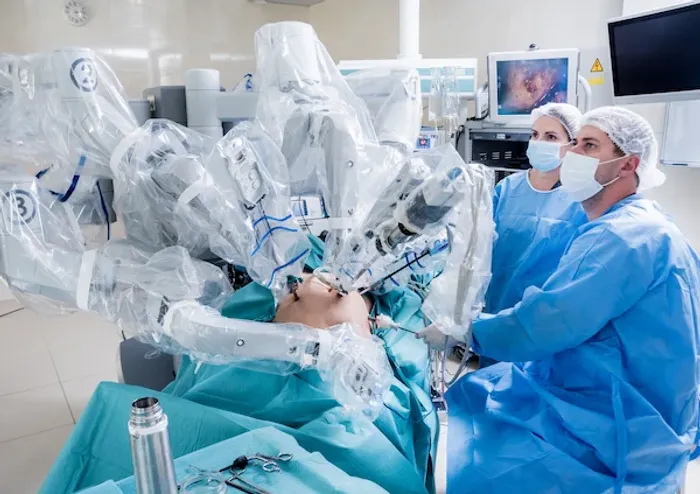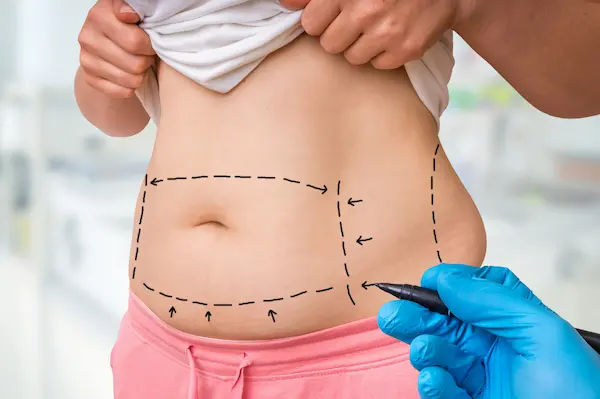Your Guide to Robotic Bariatric & Metabolic Surgery: A Modern Path to Wellness
Explore your guide to robotic bariatric and metabolic surgery, a modern path to wellness. Learn how this advanced approach offers safer procedures, faster recovery, and lasting metabolic health benefits.


For millions struggling with severe obesity and its related conditions like type 2 diabetes, high blood pressure, and sleep apnea, life can feel like an uphill battle. Traditional methods like diet and exercise, while crucial, often fall short for individuals with morbid obesity. This is where robotic bariatric and metabolic surgery has emerged as a transformative, life-changing solution. But this isn't just about shedding pounds; it's about achieving a metabolic cure. This advanced surgical approach leverages the precision of robotics to perform complex procedures with unparalleled accuracy, leading to safer operations, faster recoveries, and remarkable long-term health outcomes. This guide will walk you through everything you need to know—from understanding how the technology works and determining if you're a candidate, to what life looks like after surgery. We'll explore why the robotic approach is revolutionizing the treatment of morbid obesity, offering new hope and a sustainable path to reclaiming your health and vitality.
What is Robotic Bariatric and Metabolic Surgery?
Robotic bariatric and metabolic surgery is a minimally invasive surgical technique where a surgeon operates using a sophisticated robotic system. It's crucial to understand that the robot does not operate on its own. Instead, the surgeon controls every movement of the robotic arms from a console within the operating room. This system translates the surgeon's hand movements into smaller, more precise actions of tiny instruments inside your body.
How Robotic Surgery Differs from Traditional Laparoscopy
While both are minimally invasive (using small incisions), the key difference lies in capability and control. Traditional laparoscopy uses rigid instruments, limiting the range of motion to simple pivoting. Robotic surgery, however, uses wristed instruments that mimic the full dexterity of the human wrist. This allows for complex maneuvers like suturing and dissecting in tight spaces with greater ease and accuracy. The system also includes a high-definition 3D camera that provides the surgeon with a magnified, crystal-clear view of the surgical field, far superior to the 2D view in standard laparoscopy.
The Technology Behind the Precision: The Robotic Surgical System
The most common system is the da Vinci Surgical System. It consists of three components: the surgeon’s console, a patient-side cart with four interactive robotic arms, and a high-resolution vision system. The surgeon sits at the console, looking into a 3D viewer and manipulating the master controls. The system filters out even the slightest hand tremors, ensuring steady and precise movements. This technological edge is particularly beneficial in complex bariatric procedures performed deep within the abdomen.
Consult Top Specialists Here
Am I a Candidate? Understanding the Guidelines for Surgery
Determining candidacy for robotic bariatric surgery is a thorough process involving medical, psychological, and lifestyle evaluations. It's not a decision taken lightly by either the patient or the medical team.
BMI and Weight-Related Health Conditions
Generally, candidates have a Body Mass Index (BMI) of 40 or higher (morbid obesity), or a BMI of 35 or higher with at least one serious obesity-related comorbidity, such as:
Type 2 Diabetes
Hypertension (High Blood Pressure)
Severe Sleep Apnea
Heart Disease
Osteoarthritis
The Importance of Psychological and Nutritional Evaluation
A successful outcome depends heavily on a patient's readiness to commit to lifelong dietary and lifestyle changes. A psychological evaluation ensures you have realistic expectations and the support system needed for this journey. A nutritional assessment helps prepare you for the post-operative diet phases. If you are considering this path, consulting a multidisciplinary team, including a bariatric physician and psychologist, is essential. Platforms like Apollo24|7 can help you connect with specialists for initial consultations to discuss your candidacy.
Types of Robotic Bariatric Procedures
The two most common procedures performed robotically are the Sleeve Gastrectomy and the Gastric Bypass. The choice depends on your specific health profile and goals.
Robotic Sleeve Gastrectomy: The Restrictive Powerhouse
This procedure involves removing approximately 80% of the stomach, leaving a narrow "sleeve" or tube-shaped stomach. This significantly reduces the amount of food you can eat and removes the part of the stomach that produces the hunger hormone ghrelin. It is primarily a restrictive procedure and is very effective for weight loss and improving metabolic health.
Robotic Roux-en-Y Gastric Bypass: The Gold Standard for Metabolic Control
This is a more complex procedure that involves both restriction and malabsorption. The surgeon creates a small pouch from the top of the stomach and connects it directly to the small intestine, "bypassing" most of the stomach and the first part of the small intestine. This procedure is highly effective for achieving a metabolic cure, particularly for type 2 diabetes, often leading to resolution or significant improvement soon after surgery.
The Significant Benefits of Choosing a Robotic Approach
The advantages of the robotic system directly translate into better patient outcomes.
Enhanced Precision and Superior Outcomes
The 3D visualisation and wristed instrumentation allow for meticulous dissection and suturing. This precision is vital in navigating the complex anatomy around the stomach and intestines, leading to more consistent and reliable surgical results, which is a key benefit of robotic weight loss surgery.
Reduced Pain and a Faster Recovery
Due to enhanced precision and smaller, more careful movements, there is typically less trauma to surrounding tissues. This often results in less post-operative pain, reduced blood loss, and a shorter hospital stay. Many patients experience a quicker return to daily activities compared to traditional surgery.
Lower Risk of Complications
The improved visualisation and control help the surgeon avoid damaging critical structures, thereby reducing the risk of complications like leaks, bleeding, and infections. This enhanced safety profile makes it an excellent option for patients with higher BMIs or those needing revisional surgery.
Potential Risks and How They Are Minimised Robotically
Like any major surgery, bariatric procedures carry risks, including infection, bleeding, blood clots, and leaks from the surgical connections. However, the robotic approach is specifically designed to minimise these risks. The superior visualisation allows surgeons to identify and control bleeding vessels more effectively, and the precision suturing reduces the chance of leaks. It is vital to discuss all potential risks with your surgeon.
Life After Surgery: Embracing a Healthier Future
The surgery is a powerful tool, but long-term success depends on your commitment.
The First Year: Dramatic Weight Loss and Metabolic Improvement
The first 12-18 months post-surgery are a period of rapid transformation. Patients typically lose 60-80% of their excess weight. Conditions like type 2 diabetes often improve dramatically, sometimes within days of the procedure. Adherence to the prescribed dietary plan and incorporating gentle, then gradually increasing, physical activity is crucial. Regular follow-up, including lab tests to monitor nutrient levels, is essential. Services like Apollo24|7's home collection for tests like HbA1c and vitamin panels can make this monitoring convenient.
Long-Term Maintenance: It’s a Marathon, Not a Sprint
After the initial rapid weight loss, the focus shifts to maintenance. This involves lifelong healthy eating habits, regular exercise, taking prescribed vitamin and mineral supplements, and attending follow-up appointments. Support groups can be invaluable during this phase.
Conclusion
Robotic bariatric and metabolic surgery represents a significant leap forward in the surgical treatment of morbid obesity. By combining the skill of an experienced surgeon with the precision of advanced technology, it offers a safer, less invasive, and highly effective path to not just weight loss, but a profound metabolic reset. If you have struggled with obesity and its related health challenges, this modern approach could be the key to unlocking a healthier, more active, and fulfilling life. The journey begins with education and a conversation with a qualified healthcare professional to explore your options.
Consult Top Specialists Here
Consult Top Specialists Here

Dr. Anand Ravi
General Physician
2 Years • MBBS
Bengaluru
PRESTIGE SHANTHINIKETAN - SOCIETY CLINIC, Bengaluru

Dr. Sunil Kaul
General Surgeon
30 Years • MBBS, MS, FICS, FIMSA, FMAS
Delhi
Apollo Hospitals Indraprastha, Delhi
(25+ Patients)

Dr. Kiran K J
General and Laparoscopic Surgeon
18 Years • MBBS, MS, FMAS, DMAS (Fellow & Dip in Min. Access surg.), FALS- Bariatric & Robotic Surgery
Bengaluru
Apollo Hospitals Bannerghatta Road, Bengaluru
(50+ Patients)

Dr. Amrutha G
General Physician/ Internal Medicine Specialist
10 Years • MBBS,DNB(family medicine), Diabetologist-CCEBDM,CCGDM
Bengaluru
Apollo Clinic, Sarjapur Road, Bengaluru
Dr. Sreedhara V.
Surgical Gastroenterologist
23 Years • MBBS, DNB, FSGE
Bengaluru
Apollo Hospitals Bannerghatta Road, Bengaluru




